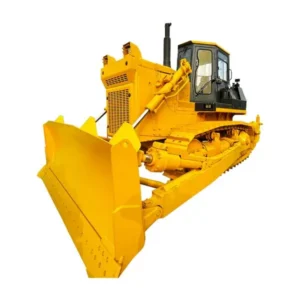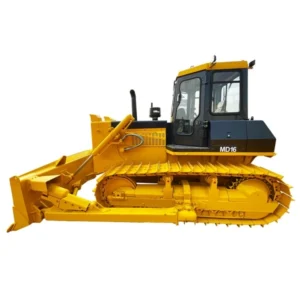Introducción
What is a bulldozer? Bulldozers are indispensable machines in the construction, mining, and land development industries. Known for their immense power and versatility, bulldozers are used for a wide range of tasks, from earthmoving to demolition. In this comprehensive guide, we will explore what a bulldozer is, how it works, and the different types of bulldozers available. By the end of this article, you will have a thorough understanding of these powerful machines and their applications.
What is a Bulldozer?

Definition and Basic Components
A bulldozer is a powerful tractor equipped with a broad, heavy blade mounted at the front. It is used for pushing large quantities of soil, sand, rubble, or other material during construction or conversion work. Bulldozers are characterized by their tracks, which provide excellent mobility over rough terrain.
Key Components of a Bulldozer
Cuchilla: The large metal plate at the front of the bulldozer used for pushing materials.
Tracks: Continuous tracks provide stability and traction on uneven ground.
Destripador: A claw-like device mounted at the rear used for breaking up hard soil and rock.
Motor: The power source of the bulldozer, typically a high-horsepower diesel engine.
Cab: The enclosed space where the operator controls the bulldozer.
How Does a Bulldozer Work?
Operational Principles
Bulldozers operate on simple yet powerful mechanical principles. The engine generates power, which is transmitted to the tracks through a transmission system. The operator controls the movement and the blade’s position using hydraulic or electric systems.
Blade Functions and Operations
The blade is the primary tool of a bulldozer. Depending on the type of blade, bulldozers can perform various tasks:
- Straight Blade (S-Blade): Short with no lateral curve, ideal for fine grading.
- Universal Blade (U-Blade): Tall and curved, designed for pushing large quantities of material.
- Semi-U Blade (SU-Blade): Combines features of S-Blade and U-Blade for versatile operations.
Types of Bulldozers
Bulldozers come in various types, each designed for specific tasks and environments. Understanding these types helps in selecting the right machine for the job.
Crawler Bulldozers
Crawler bulldozers, also known as track bulldozers, are the most common type. They provide excellent traction and stability, making them ideal for rough terrains and heavy-duty tasks.
Wheel Bulldozers
Wheel bulldozers are equipped with large, heavy-duty tires instead of tracks. They are more maneuverable and faster on flat or semi-rough terrain compared to crawler bulldozers.
Mini Bulldozers
Mini bulldozers are smaller versions of standard bulldozers. They are perfect for light to medium tasks in confined spaces such as residential projects and small-scale landscaping.
Applications of Bulldozers
Construcción
In construction, bulldozers are used for site preparation, grading, and leveling. They can efficiently move large amounts of material, making them essential for large construction projects.
Minería
In mining, bulldozers are used for clearing land, removing overburden, and maintaining haul roads. Their ability to operate in tough conditions makes them invaluable in mining operations.
Land Development
Bulldozers are used in land development for tasks such as clearing land, building roads, and preparing the ground for agricultural use. Their versatility allows them to handle a variety of land development tasks.
Table: Comparison of Bulldozer Types

To provide a clearer understanding of the different bulldozer types, here is a comparison table highlighting their key features and typical applications:
| Bulldozer Type | Key Features | Typical Applications |
|---|---|---|
| Crawler Bulldozers | Tracks for stability, high power, versatile blade | Construction, mining, land development |
| Wheel Bulldozers | Heavy-duty tires, maneuverability, speed | Road construction, material handling |
| Mini Bulldozers | Compact size, lightweight, precision | Residential projects, small-scale tasks |
Conclusion: What is a bulldozer?
topadoras are powerful and versatile machines that play a crucial role in various industries. Understanding what a bulldozer is and how it works can help you choose the right type of bulldozer for your specific needs. Whether you are involved in construction, mining, or land development, selecting the appropriate bulldozer type can enhance productivity, safety, and efficiency.
Preguntas Frecuentes
What is a bulldozer used for?
A bulldozer is used for pushing large quantities of soil, sand, rubble, or other material during construction or conversion work. It is commonly used in construction, mining, and land development for tasks such as site preparation, grading, and material handling.
How do you operate a bulldozer?
Operating a bulldozer involves controlling the movement and blade position using hydraulic or electric systems. The operator uses levers and pedals to steer, accelerate, and manipulate the blade. Proper training is essential for safe and efficient operation.
What are the different types of bulldozers?
The main types of bulldozers include crawler bulldozers, wheel bulldozers, and mini bulldozers. Each type is designed for specific tasks and environments, providing various levels of power, maneuverability, and stability.
How does a bulldozer differ from an excavator?
While both bulldozers and excavators are used in construction and earthmoving, they serve different purposes. Bulldozers are primarily used for pushing and grading materials, while excavators are used for digging and lifting. Excavators typically have a boom and bucket, whereas bulldozers have a large front blade.
What should you consider when buying a bulldozer?
When buying a bulldozer, consider factors such as the type of terrain, the specific tasks you need to perform, the machine’s power and size, and your budget. It’s also important to consider the manufacturer’s reputation and the availability of maintenance and support services.








-150x150.webp)
